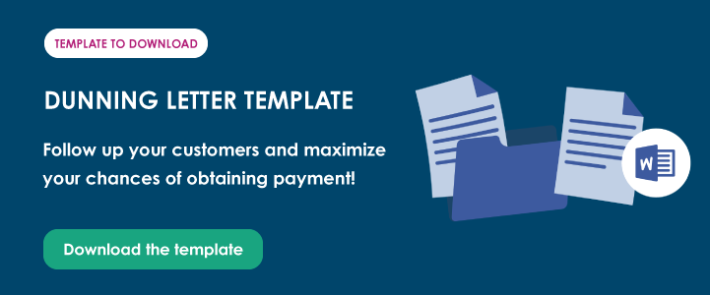Has one of your customers failed to pay an invoice on time? Are you wondering how best to obtain payment without offending your customer? Amicable collection is the first phase of debt collection. It involves setting up a debt collection process aimed at finding an amicable solution with the creditor. This may involve immediate repayment of the unpaid invoice, or an agreement to grant additional time for payment, or to set up a payment schedule. In all cases, amicable debt collection is based on communication between the creditor company and its debtor customer. But how does amicable debt collection work in practice? What are the main stages in the amicable debt collection process? Here are all the explanations and advice you need for successful out-of-court debt collection.
Would you like to send a dunning letter to your creditor? Download our dunning letter template, fill in the essential information and send your letter.
The advantages of amicable debt collection
Amicable collection is a very advantageous type of collection for a company.
Indeed, the primary advantage of amicable debt collection is that it helps maintain good relations with customers. Amicable debt collection actions are carried out in such a way as to maintain communication and preserve the business relationship. Delay may be due to a simple oversight or to a delay in accounting processing. It is therefore preferable to avoid threatening the customer with legal proceedings or late payment penalties from the very first exchange after the invoice due date.
This also goes hand in hand with preserving the company’s reputation. Legal proceedings are never good for a company’s image. Amicable debt collection allows you to be more discreet.
Amicable debt collection is quick and easy to set up. What’s more, if a good amicable debt collection process is deployed within the company, efficiency is guaranteed. It’s a method that pays off when it comes to reducing payment delays.
What’s more, setting up an amicable collection procedure is less costly than taking legal action.
The final advantage of amicable collection is that it makes it easier to win the case if it ultimately goes to court. If, despite the creditor company’s best efforts, amicable collection efforts have failed, the judge will be more inclined to rule in the creditor company’s favor if all the legal elements are present. It is therefore important to be able to prove the efforts made to find an amicable solution.
Amicable debt collection offers many advantages. However, to benefit from it, the company must master the way it works and know the key steps to follow.
How amicable collection works
Communication with the debtor is the cornerstone of amicable debt collection. Indeed, to find an amicable settlement, it is essential that the parties – creditor and debtor – are able to communicate cordially and in good faith.

This is why the creditor’s amicable collection actions must be both clear and firm on the need to obtain payment of the debt, and open the door to negotiations if necessary.
Depending on the customer’s financial situation, he or she may not always be able to pay the debt in full immediately. It is therefore advisable to assess the customer’s financial situation, in particular by consulting the debtor’s sirene status notice. The aim is to give you an idea of what may or may not be possible, and to protect the company in the event of the situation developing into a collective procedure (safeguard, reorganization or judicial liquidation).
Depending on the financial situation of both the debtor and the creditor, the parties can negotiate different terms for payment of the outstanding debt. In most cases, the agreement concerns the granting of an additional payment period, or the setting up of a payment schedule. It is strongly recommended to formalize this out-of-court settlement agreement in writing. In addition, conditions can be attached to the agreement, such as the suspension of new orders pending full payment, or cash payment for all new orders.
Should the debtor fail to meet its commitment, the creditor may terminate the amicable agreement and initiate another collection procedure, such as forced collection or judicial collection.
Key stages in the amicable collection process
 Even if it’s an amicable collection procedure, it’s essential to respect the key stages of the amicable collection process.
Even if it’s an amicable collection procedure, it’s essential to respect the key stages of the amicable collection process.
On the one hand, this maximizes the chances of recovering the debt, and on the other hand, it facilitates proof if the dispute has to go to court at a later date.
The main stages in the amicable debt collection process are :
- verification of information relating to the claim ;
- initial contact with the debtor ;
- Dunning ;
- proposing repayment solutions;
- regular monitoring of commitments ;
- sending a letter of formal notice.
Verification of claim information
The first step in an amicable debt collection procedure is to check the information relating to the debt.
Before contacting the customer to notify him or her of late payment, it’s a good idea to check that the invoice is indeed overdue. Failure to do so risks irritating your customer and damaging the company’s image. So if the invoice status has just been changed to unpaid, you need to check the latest payments received to make sure you’re up to date with payment tracking.
Using collection software like CashOnTime not only makes it easy to track the status of invoices, but also to link them to cash receipts. Then, when an unpaid invoice is detected, a series of actions can be initiated automatically thanks to automation.
Automate your debt collection with CashOnTime.
En outre, il est essentiel de vérifier que la créance remplit les conditions légales prévues par le Code civil avant de pouvoir lancer une procédure de recouvrement amiable. Par exemple, la créance doit être certaine, liquide et exigible, et non prescrite.
Ce n’est qu’une fois ces vérifications d’usage effectuées que vous pourrez passer à la deuxième étape du processus de recouvrement amiable.
Premier contact avec le débiteur

The initial contact with the debtor company is crucial in the event of an unpaid invoice. You need to be both firm and cordial.
You can inform the debtor of your late payment by telephone or e-mail. These methods are less formal than a letter, for example, and provide a rapid response. They are also very effective for initiating discussion and understanding the reasons for the unpaid debt.
Dunning
There is no legal requirement to send out reminders for unpaid invoices. However, it is strongly recommended that you adopt this practice. Firstly, because it often helps to find a rapid solution and therefore reduce the time taken to pay outstanding invoices. Secondly, because it demonstrates the creditor company’s willingness to find an amicable solution. This will be appreciated by the judge if amicable collection fails and compulsory collection proceedings are initiated.
Dunning notices can be sent by :
- téléphone ;
- e-mail ;
- simple letter.
Once again, for simplicity’s sake, it’s best to opt for a telephone reminder or an e-mail reminder. The latter solution is certainly the most appropriate, as it provides written proof of the amicable steps taken by the creditor.
Proposing repayment solutions

Even if the creditor company’s objective is to obtain full and immediate settlement of the outstanding debt, it is necessary to remain open to negotiation.
The creditor company rarely initiates the proposal for amicable solutions. However, in its dealings and in the course of its various exchanges with the debtor, it must state that it is prepared to consider any serious proposal for an out-of-court settlement.
In this way, the debtor can make a proposal to obtain additional payment time or to spread the payments over time.
If the debtor accepts the repayment proposal, it is advisable to formalise it in writing, signed by both parties.
Regular monitoring of compliance with commitments
Acceptance of an out-of-court settlement requires regular monitoring. The creditor must ensure that the debtor fulfils its commitments. For example, the creditor must check that the debtor pays the agreed instalments on time.
If the debtor fails to honour his commitments, the creditor can terminate the agreement by sending a letter of formal notice.
Formal notice
The letter of formal notice can be sent in the event of :
- no response from the debtor following reminders sent by the debtor ;
- no amicable solution ;
- non-compliance with the amicable settlement agreement previously put in place.

This letter, sent by recorded delivery with acknowledgement of receipt to the debtor, is the final stage in the amicable debt collection process. If no payment has been made, or if no agreement has been reached by the end of the period allowed in the formal notice – usually 15 days – the creditor may request that legal collection proceedings be initiated.
What’s more, it is the formal notice that marks the start of the calculation of interest and late payment penalties. This is why sending the formal notice is the creditor’s only legal obligation in amicable debt collection.
The formal notice to pay must therefore include certain mandatory information:
- the words “mise en demeure” ;
- the date of writing ;
- the creditor’s details ;
- the debtor’s contact details ;
- the nature of the debtor’s obligation (in this case, the obligation to pay);
- a summary of the facts and the dispute ;
- the deadline for rectifying the situation ;
- a reminder of the consequences of non-payment;
- the sender’s signature.
You should also enclose an up-to-date statement of the sums due. You can also enclose a copy of the unpaid invoice.
5 tips for successful out-of-court debt collection

To optimise your company’s amicable debt collection process and maximise your chances of recovering your debts, here are 5 best practices to adopt:
- maintain open and respectful communication ;
- establish realistic payment schedules;
- document all interactions with the debtor ;
- use collection software ;
- call in collection professionals if necessary.
Maintaining open and respectful communication
As you will have realised, communication is the key to successful amicable debt collection. To be beneficial, this communication must remain open and respectful.
But managing contentious situations with customers can require real know-how. You can train your staff in good practice in this area.
Adopting the right posture and the right verbatim can make a real difference to the amicable recovery of your debts. And, as a result, help you to better manage your cash flow, working capital and WCR.
Establish realistic payment schedules
If you manage to reach an amicable settlement with your debtor, make sure that the repayment plan you put in place is realistic.
The aim of drawing up a payment schedule is not to waste your time. However, this can quickly become the case because of the regular monitoring involved, especially if you have to follow up with the debtor at each payment date.
There’s no point in setting up a payment schedule that your debtor won’t be able to keep to over time. It may be more appropriate to plan a longer term with smaller instalments, but to be certain that the agreement will be respected.
If, however, this is not possible because your company cannot afford to grant such deadlines, it may be advisable to find another solution.
Document all interactions with the debtor

To ensure that your amicable debt collection file is properly followed up, it is essential to keep all the records of your dealings with your debtor customer. This is relatively easy for e-mails and letters. However, telephone exchanges can be more complicated. In this case, you can make a quick note of the content of the conversation and any commitments made in an email to the debtor. This also ensures that there are no misunderstandings.
In addition to monitoring the case, documenting interactions with the debtor helps to build up a body of evidence should the need arise.
Using collection software
To simplify your amicable debt collection process and save your staff time, equipping them with debt collection software is a very good solution.
Collection software allows you to :
- track payments ;
- monitor the status of invoices ;
- perform accounting lettering;
- send out reminder letters using automated tools ;
- access a dashboard to control customer risk.
Generally speaking, the use of debt collection software saves teams time, allowing them to devote their efforts to the most complex cases.
CashOnTime is a comprehensive solution, published by DIMO Software, that structures receivables management from the automation of collection processing through to debt recovery. Credit management, collection, litigation and lettering solutions are at the heart of this collection software.
REQUEST A DEMO OF OUR SOLUTION
Call in collection professionals if necessary.
Finally, to ensure that your amicable debt collection is a success, you can call on the services of debt collection professionals such as :
- a lawyer ;
- a judicial commissioner (bailiff) ;
- a collection company.
Conclusion
Amicable debt collection offers many advantages to businesses, not least the maintenance of good relations with their customers. The effectiveness of amicable debt collection depends on the key stages being followed, as well as the adoption of good practice. Implementing these tips offers a better chance of recovering unpaid debts without having to involve the courts.
